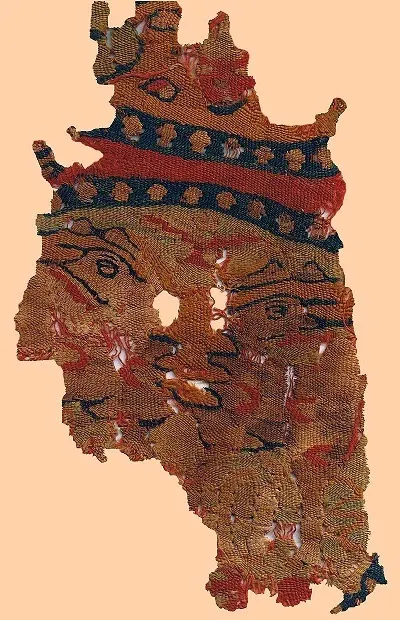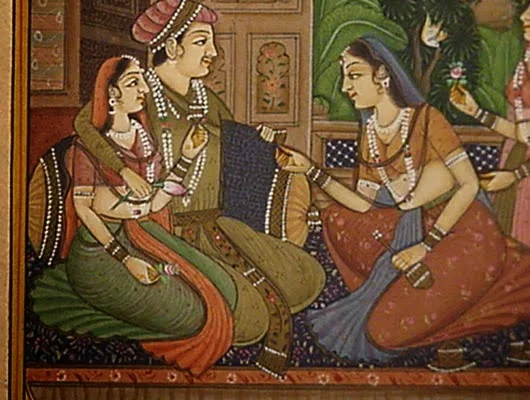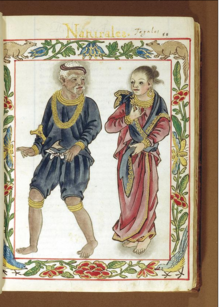 It’s unknown when humans began wearing clothes but it was the biggest step thousands of years ago. According to the anthropologists believe humans used animal skins and other natural material to protect themselves from cold, heat and rain or may be for other purposes such as magic, decoration, cult or prestige. Prehistoric evidence shows that humans have began wearing cloths as far back as 100,000 to 500,000 years ago. On the other hand genetic analysis on human body louse supports evidence that humans began wearing cloths around 107 thousand years ago.
It’s unknown when humans began wearing clothes but it was the biggest step thousands of years ago. According to the anthropologists believe humans used animal skins and other natural material to protect themselves from cold, heat and rain or may be for other purposes such as magic, decoration, cult or prestige. Prehistoric evidence shows that humans have began wearing cloths as far back as 100,000 to 500,000 years ago. On the other hand genetic analysis on human body louse supports evidence that humans began wearing cloths around 107 thousand years ago.What about sewing needles? Yes, possible sewing needles have been dated to around 40,000 years ago. The earliest needles originated from the Solutrean culture in France from 19,00 BC to 15,00 BC. The earliest dyed flax fibers have been found in a prehistoric cave in the Republic of Georgia and date back to 36,000 BP.
The earliest evidence of weaving comes from impressions of textiles and basketry and nets on little pieces of hard clay, dating from 27,000 years ago and found in Dolni Vestonice in the Czech Republic.
25,000 years ago the Venus figurines were depicted with clothing. Western European wore basket hats or caps, belts at the waist and strap of cloth that wrapped around the body right above the breast. Eastern European figurines wore belts, hung low on the hips and sometimes string skirts. Around 5000 BC archaeologists have discovered artifacts that have been used in the textile arts like net gauges, spindle needles and weaving sticks. The first actual textile was probably felt and Nålebinding (binding with a needle) is the early surviving textile method date from 6500 BC.
Our knowledge of ancient textiles and clothing has driven us to the modern technological developments. We will look into the archeological deposits from ancient Near East, India, Egypt, China, Japan and Phlippines.
The earliest known woven textiles may be fabrics used to wrap the dead, excavated at Neolithic site at Çatalhöyük in Anatolia in the Near East and radiocarbon dated to c. 6000 BC. Also evidence exists of flax cultivation from c. 8000 BC.
Spinning techniques included the drop spindle, hand-to-hand spinning, and rolling on the thigh; yarn was also spliced. A horizontal ground loom was used prior to the New Kingdom, when a vertical two-beam loom was introduced, probably from Asia.
Linen bandages were used in the burial custom of mummification, and art depicts Egyptian men wearing linen kilts and women in narrow dresses with various forms of shirts and jackets, often of sheer pleated fabric.
Main Article: Clothingin the ancient world - Egyptian clothing
Under the Shang Dynasty, Han Chinese clothing or Hanfu consisted of a yi, a narrow-cuffed, knee-length tunic tied with a sash, and a narrow, ankle-length skirt, called shang, worn with a bixi, a length of fabric that reached the knees. Clothing of the elite was made of silk in vivid primary colours.
Ancient Near East
The earliest known woven textiles may be fabrics used to wrap the dead, excavated at Neolithic site at Çatalhöyük in Anatolia in the Near East and radiocarbon dated to c. 6000 BC. Also evidence exists of flax cultivation from c. 8000 BC.
Ancient India
"Cotton has been spun, woven, and dyed since prehistoric times. It clothed the people of ancient India, Egypt, and China. Hundreds of years before the Christian era cotton textiles were woven in India with matchless skill, and their use spread to the Mediterranean countries. In the 1st cent. Arab traders brought fine Muslin and Calico to Italy and Spain. The Moors introduced the cultivation of cotton into Spain in the 9th cent. Fustians and dimities were woven there and in the 14th cent. in Venice and Milan, at first with a linen warp. Little cotton cloth was imported to England before the 15th cent., although small amounts were obtained chiefly for candlewicks. By the 17th cent. the East India Company was bringing rare fabrics from India. Native Americans skilfully spun and wove cotton into fine garments and dyed tapestries. Cotton fabrics found in Peruvian tombs are said to belong to a pre-Inca culture. In color and texture the ancient Peruvian and Mexican textiles resemble those found in Egyptian tombs."
Ancient Egypt
Evidence exists for production of linen cloth in Ancient Egypt in the Neolithic period, c. 5500 BC. Cultivation of domesticated wild flax, probably an import from the Levant, is documented as early as c. 6000 BC Other bast fibers including rush, reed, palm, and papyrus were used alone or with linen to make rope and other textiles. Evidence for wool production in Egypt is scanty at this period.
Spinning techniques included the drop spindle, hand-to-hand spinning, and rolling on the thigh; yarn was also spliced. A horizontal ground loom was used prior to the New Kingdom, when a vertical two-beam loom was introduced, probably from Asia.
Linen bandages were used in the burial custom of mummification, and art depicts Egyptian men wearing linen kilts and women in narrow dresses with various forms of shirts and jackets, often of sheer pleated fabric.
Main Article: Clothingin the ancient world - Egyptian clothing
Ancient China
The earliest evidence of silk production in China was found at the sites of Yangshao culture in Xia, Shanxi, where a cocoon of bombyx mori, the domesticated silkworm, cut in half by a sharp knife is dated to between 5000 and 3000 BC. Fragments of primitive looms are also seen from the sites of Hemudu culture in Yuyao, Zhejiang, dated to about 4000 BC. Scraps of silk were found in a Liangzhu culture site at Qianshanyang in Huzhou, Zhejiang, dating back to 2700 BC. Other fragments have been recovered from royal tombs in the Shang Dynasty (c. 1600 – c. 1046 BC).
Under the Shang Dynasty, Han Chinese clothing or Hanfu consisted of a yi, a narrow-cuffed, knee-length tunic tied with a sash, and a narrow, ankle-length skirt, called shang, worn with a bixi, a length of fabric that reached the knees. Clothing of the elite was made of silk in vivid primary colours.
Main Articles: History of silk and Hanfu
Ancient Japan
The earliest evidence of weaving in Japan is associated with the Jōmon period. This culture is defined by pottery decorated with cord patterns. In a shell mound in the Miyagi Prefecture, dating back about 5,500, some cloth fragments were discovered made from bark fibers. Hemp fibers were also discovered in the Torihama shell midden, Fukui Prefecture, dating back to the Jōmon period, suggesting that these plants could also have been used for clothing. Some pottery pattern imprints depict also fine mat designs, proving their weaving techniques. Since bone needles were also found, it is assumed that they wore dresses that were sewn together.
Classical Period- Phlippines
The classical Filipino clothing varied according to cost and current fashions and so indicated social standing. The basic garments were the Bahag and the tube skirt—what the Maranao call malong—or a light blanket wrapped around instead.
But more prestigious clothes, lihin-lihin, were added for public appearances and especially on formal occasions—blouses and tunics, loose smocks with sleeves, capes, or ankle-length robes.
The textiles of which they were made were similarly varied. In ascending order of value, they were abaca, abaca decorated with colored cotton thread, cotton, cotton decorated with silk thread, silk, imported printstuff, and an elegant abaca woven of selected fibers almost as thin as silk. In addition, Pigafetta mentioned both G-strings and skirts of bark cloth.
But more prestigious clothes, lihin-lihin, were added for public appearances and especially on formal occasions—blouses and tunics, loose smocks with sleeves, capes, or ankle-length robes.
The textiles of which they were made were similarly varied. In ascending order of value, they were abaca, abaca decorated with colored cotton thread, cotton, cotton decorated with silk thread, silk, imported printstuff, and an elegant abaca woven of selected fibers almost as thin as silk. In addition, Pigafetta mentioned both G-strings and skirts of bark cloth.
Reference: Wikipedia







%20in%20the%20Garment%20Industry.jpg)


3 Comments
benefits and challenges of telehealth
ReplyDeleteWhat Are The Benefits of Dark Chocolate?
ReplyDeleteThere are several benefits of a dark chocolate. It improves memory, keeps skin youthful, good for bodybuilding, pregnancy, and prevents heart disease.
Do you need a quick long or short term Loan with a relatively low interest rate as low as 3%? We offer business Loan, personal Loan, home Loan, auto Loan,student Loan, debt consolidation Loan e.t.c. no matter your credit score.
ReplyDeletePersonal Loans (Secure and Unsecured)
Business Loans (Secure and Unsecured)
Consolidation Loan and many more.
Asia Loan Company Ltd
asialoancompanyltd@gmail.com
Call/Whats-App +919319926618
Dr. Sipos Csaba